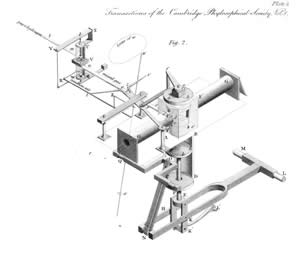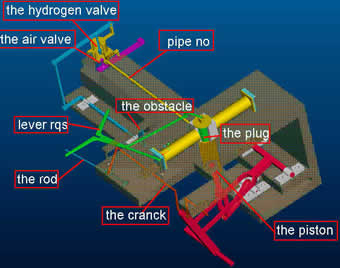The Rev. W. Cecil's Engine
 In 1820, the Rev. W. Cecil wrote a paper entitled: "On the application of
hydrogen gas to produce a moving power in machinery; with a description of
an engine which is moved by pressure of the atmosphere upon a vacuum caused
by explosions of hydrogen gas and atmospheric air." In this document, he explains
how to use the energy of hydrogen to power an engine and how the hydrogen
engine could be built.
In 1820, the Rev. W. Cecil wrote a paper entitled: "On the application of
hydrogen gas to produce a moving power in machinery; with a description of
an engine which is moved by pressure of the atmosphere upon a vacuum caused
by explosions of hydrogen gas and atmospheric air." In this document, he explains
how to use the energy of hydrogen to power an engine and how the hydrogen
engine could be built.
How does it work...?
The principle:
The general principle of this engine is founded upon the property, which hydrogen gas mixed with atmospheric air possesses, of exploding upon ignition, so as to produce a large imperfect vacuum. If two and a half measures, by volume, of atmospheric air are mixed with one measure of hydrogen, and a flame applied, the mixed gas will expand into a space rather greater than three times its original volume.
The products of the expolsion are:
- a globule of water, formed by the union of the hydrogen with the oxygen of the atmospheric air
- and a quantity of nitrogen, which in its natural state (density=1) constitutes 0.556 of the mixed gas, by volume.
 The
same quantity of nitrogen is now expanded into a space somewhat greater than
three times the original volume of the mixed gas; that is, into about six
times the space which it previously occupied: its density relative to the
atmosphere is therefore about 1/6. If the external air is prevented, by a
proper apparatus, from returning into this imperfect vacuum, the pressure
of the atmosphere may be employed as a moving force, nearly in the same manner
as in a steam-engine: the difference being chiefly in the manner of forming
the vacuum.
The
same quantity of nitrogen is now expanded into a space somewhat greater than
three times the original volume of the mixed gas; that is, into about six
times the space which it previously occupied: its density relative to the
atmosphere is therefore about 1/6. If the external air is prevented, by a
proper apparatus, from returning into this imperfect vacuum, the pressure
of the atmosphere may be employed as a moving force, nearly in the same manner
as in a steam-engine: the difference being chiefly in the manner of forming
the vacuum.
The strokes:
The first stroke is the intake. It starts when the piston is going down. At this moment, the rod sweeps across with a rapid angular motion carrying the lever, and thus the plug to the right.
By this motion:
- the vertical cylinder will be separated from the horizontal cylinders
- the small ports will be opened, admitting the atmospheric air freely into the horizontal cylinders
- and the mouth of the pipe will be opened to the inside of the cube, i. e. to the cylinder.
As the piston begins to descend, the atmospheric air will rush in at the air valve, which opens spontaneously and will occupy whatever portion of the cylinder is relinquished by the descent of the piston.
Secondly, the hydrogen valve is opened, by the rod touching an obstacle (Animation). At the end of the contact, the hydrogen valve is closed and the atmospheric air valve is spontaneously opened until the end of the descent of the piston.
Before the piston reaches its lowest point, the rod strikes against a lever, causing a rapid motion of the plug to the left which means that:
- at the beginning the pipe is closed, as are the small ports;
- the two horizontal cylinders are opened;
- the little hole (c) is opened and shuts again at the end of the motion.
The flame of a lamp constantly burning before the touch-hole causes the mixed gas to ignite and expand so as to occupy the whole interior of the three cylinders and thus the common gas in the horizontal cylinder is expelled at the valves.
Hence the imperfect vacuum will be formed in all three cylinders, and the piston will ascend by the pressure of the atmosphere. The plug is now moved to the right by the transition of the rod, and the piston descends by the momentum of a fly wheel on the crank acquired during the ascent, and is followed by a fresh portion of mixed gas drawn in from the pipe as before.
To see the whole cycle click here.
